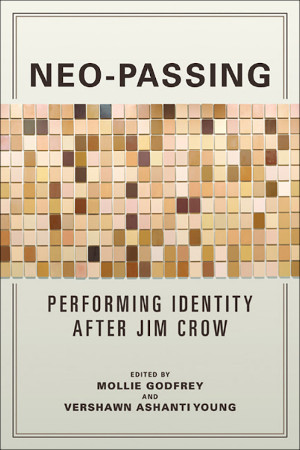 Neo-Passing: Performing Identity After Jim Crow explores the transformation and expansion of the concept of "passing" since the Jim Crow Era. The collection of essays, edited by Mollie Godfrey and Vershawn Ashanti Young, seeks to explore why passing persists and the ways in which contemporary understandings of multiculturalism and intersectionalism in the United States have impacted passing. The book was published in 2018, three years after the Rachel Dolezal controversy ignited discussions about racial passing and "transracialism" in the news, public scholarship, and traditional academia. Neo-Passing asks: How does passing allow us to uniquely to understand the construction of race through social processes? What does passing reveal about the performative nature of identity and intersections of race, class, gender, sexuality, and ability?
Neo-Passing: Performing Identity After Jim Crow explores the transformation and expansion of the concept of "passing" since the Jim Crow Era. The collection of essays, edited by Mollie Godfrey and Vershawn Ashanti Young, seeks to explore why passing persists and the ways in which contemporary understandings of multiculturalism and intersectionalism in the United States have impacted passing. The book was published in 2018, three years after the Rachel Dolezal controversy ignited discussions about racial passing and "transracialism" in the news, public scholarship, and traditional academia. Neo-Passing asks: How does passing allow us to uniquely to understand the construction of race through social processes? What does passing reveal about the performative nature of identity and intersections of race, class, gender, sexuality, and ability?
In their introduction to the book, Godfrey and Young note the potential conflict between defining race as a social construct and protecting black histories and culture from white appropriation (Godfrey 13). After Godfrey and Young lay out the thematic concerns and scope of Neo-Passing in their introduction, they include a ten-page "Appendix to the Introduction. Neo-Passing Narratives: Teaching and Scholarly Resources," which is organized by genre. The book is then split into two halves, each including five essays that are prefaced by an "opening think piece." The first half of the book, entitled "New Histories," examines historical black-to-white passing from new angles and reveals residues of older racial regimes in contemporary trends towards seemingly embracing racial hybridity. The second half of the book, "New Identities," opens up passing to include multiple and potentially more fluid identity types. The essays analyze passing narratives from a range of literary genres (contemporary and historical fiction, short stories, and journalistic narratives), as well as comic books, film, comedy bits, and reality television.
Overall, Neo-Passing provides an excellent foundation in passing in the United States and the themes and concerns which currently animate passing scholarship. The structure of the book is intuitive and clearly laid out in Godfrey and Young's general introduction. In particular, Martha J. Cutter's essay, which traces passing from the mid-1750s to 2000s, builds upon Allyson Hobbs' opening think piece to concisely contextualize the history of passing in the United States. Additionally, the appendix of neo-passing narratives contains a goldmine of artistic and scholarly sources for those who wish to dive deeper into the study of passing.
I found the "New Histories" half of the book more compelling than the "New Identities" half. Different perspectives on (racial) neo-passing include objects of analysis ranging from Dave Chappelle's Black Bush skits to Matt Johnson and Warren Pleece's comic book, Inconegro. Still, the "New Histories" essays largely cohere around rebuttals against or interventions within the ideology of postracialism. The "New Identities" section significantly broadens the scope of passing. As a result, there are more noticeable gaps in the coverage provided by the five "New Identities" essays, and I found it more difficult to draw connections between the writers' disparate focuses. All five essays center U.S. narratives of passing, and while Neo-Passing grounds passing in the specific racial history of the United States, I believe the expansion of passing identities should be in conversation with narratives of passing and systems of identity construction from other countries and cultures. Additionally, though Marcia Alesan Dawkin's opening think piece for "New Identities" theorizes links between traditional passing narratives and passing through social media, the five "New Identities" essays do not reference social media at all. This likely speaks to the difficulty of identifying an organizing thread between the essays in this section. Moreover, given the prominent role of social media in U.S. electoral politics, antiracism organizing, and the virality of Rachel Dolezal, I find it surprising that most essays in this collection do not explicitly address social media.
Neo-Passing would serve as an accessible starting point for upper level undergraduates, graduates, and scholars who are interested in the construction of passing as a phenomenon and the history of racial passing in the United States. Those studying the construction of identities and social groups more broadly might also benefit from Neo-Passing's explorations of passing. Some previous familiarity with African American studies, critical race theory, gender studies, and queer theory would be helpful, but the essays in Neo-Passing are not heavily theoretical. Lastly, though Neo-Passing's explorations of new iterations of passing remain incomplete, its thought-provoking essays and working bibliography of neo-passing narratives inspire excitement and curiosity about future work on passing.
— Reviewed by Nia Wilson, Texas A&M University
Nia Wilson is a graduate student of the Performance Studies Department at Texas A&M University. They are conducting research on bachata dance communities in New York City. Their research interests include cross-cultural and queer navigations of intimacy through dance and transnational adoption and racial identity. They received a bachelor's degree in Literature and Theatre from New York University Abu Dhabi.


